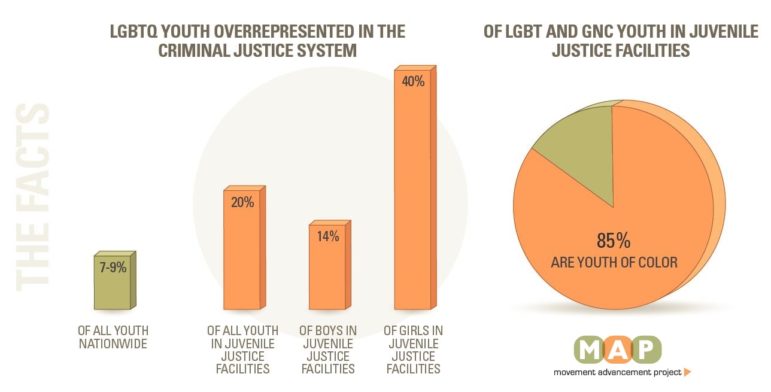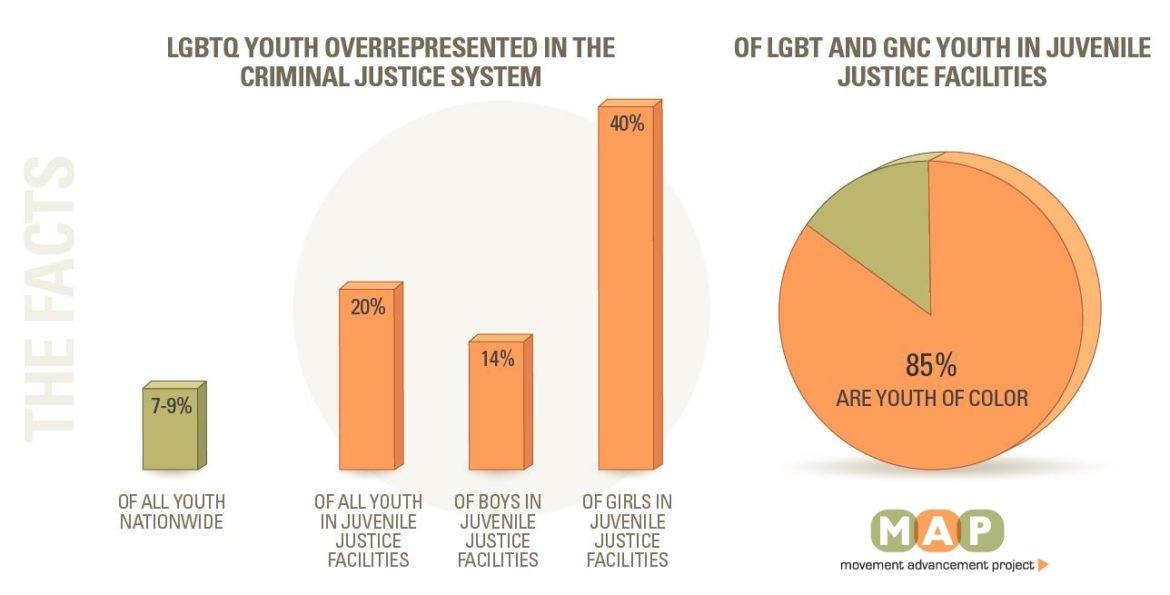
Stigma and discrimination, unsafe schools and discriminatory policing drive lesbian, gay, bisexual, transgender and queer youth into the justice system where they are overrepresented and subject to unfair treatment and abuse, says a new report.
Studies show that while LGBT youth make up about 7 to 9 percent of the population, they account for larger percentages of youth in juvenile justice facilities, according to the report by the Movement Advancement Project and the Center for American Progress.
In a survey by the federal Bureau of Justice Statistics, 12 percent of youth in juvenile justice facilities self-identified as nonheterosexual.
Another survey by the National Council on Crime and Delinquency of seven facilities found that 20 percent of youth identified as LGBT or gender nonconforming. In the same survey, 40 percent of girls in juvenile justice facilities identified as LGBT, while 85 percent of nongender-conforming youth were youth of color.
“This report confirms once and for all what many of us have known for some time: LGBTQ young people are grossly overrepresented in the juvenile justice system, and it’s no coincidence. We live in a society where discrimination and stigma too often lead to criminalization and mistreatment at the hands of law enforcement,” said Ineke Mushovic, executive director of the Movement Advancement Project (MAP), in a news release.
The report highlights research on the experiences of LGBT youth to create a portrait of what factors help push them into the justice system, what happens once they are there and recommendations for change.
The hope is that a comprehensive round of the research can encourage a conversation about solutions that can make a difference for LGBT youth. The report’s recommendations include reducing homelessness for LGBT youth, reforming policing strategies and improving support for LGBT youth when they are released from facilities.
Naomi Goldberg, MAP policy and research director, said the field has taken an interest in LGBT youth once they are in custody, as part of a broader conversation about conditions of confinement. But conversations about how LGBT youth end up in the system also are beginning, especially at the local level.
“I think there are places where city officials and advocates are recognizing that LGBTQ youth are overrepresented and are particularly vulnerable, but it doesn’t feel like a conversation that is happening systemwide the way conditions of confinement conversations are,” she said.
One opening for a broader conversation could come as cities consider how to improve policing policies, Goldberg said.
“My hope is that LGBT people will be a part of those conversations,” she said.
The new report is a companion to one the co-authors released earlier this year that looks at the experiences of all LGBT people in the justice system, including youth.
Youth experiences
The report traces some of the reasons LGBT youth are disproportionately likely to end up in the justice system.
For example, family stigma or mistreatment in the child welfare system can mean youth run away and stay on the streets, making it more likely they will encounter law enforcement. Similarly, students who are bullied in school because of their sexual orientation or gender identity may be more likely to miss class or drop out. They then could face charges such as truancy or otherwise come in contact with the justice system.
Once in the system, studies show LGBT youth are more likely to be held while awaiting adjudication, are vulnerable to sexual assault and abuse, and do not receive the services they need for a smooth re-entry into the community.
“Their experiences in these systems are a huge threat to their lives and life chances, and we are doing far too little to prepare them for a healthy and productive life after release,” said Shannon Wilber, youth project director of the National Center for Lesbian Rights.

Pingback: Queer Finance 101: Ten Ways That Sexual and Gender Identity Affect Finances • Bitches Get Riches